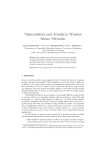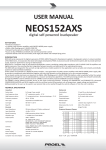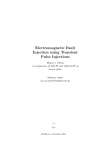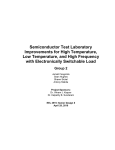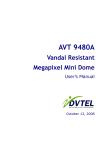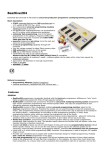Download Flash Memory `Bumping` Attacks
Transcript
Flash Memory ‘Bumping’ Attacks Sergei Skorobogatov University of Cambridge, Computer Laboratory, 15 JJ Thomson Avenue, Cambridge CB3 0FD, United Kingdom [email protected] Abstract. This paper introduces a new class of optical fault injection attacks called bumping attacks. These attacks are aimed at data extraction from secure embedded memory, which usually stores critical parts of algorithms, sensitive data and cryptographic keys. As a security measure, read-back access to the memory is not implemented leaving only authentication and verification options for integrity check. Verification is usually performed on relatively large blocks of data, making brute force searching infeasible. This paper evaluates memory verification and AES authentication schemes used in secure microcontrollers and a highly secure FPGA. By attacking the security in three steps, the search space can be reduced from infeasible > 2100 to affordable ≈ 215 guesses per block of data. This progress was achieved by finding a way to preset certain bits in the data path to a known state using optical bumping. Research into positioning and timing dependency showed that Flash memory bumping attacks are relatively easy to carry out. Keywords: semi-invasive attacks, fault injection, optical probing 1 Introduction Confidentiality and integrity of sensitive information stored in smartcards, secure microcontrollers and secure FPGAs is a major concern to both security engineers and chip manufacturers. Therefore, sensitive data like passwords, encryption keys and confidential information is often stored in secure memory, especially in Flash memory. This is mainly because data extraction from an embedded Flash memory is believed to be extremely tedious and expensive [1, 2]. In addition, Flash memory offers re-programmability and partial updating, useful for keeping firmware, keys and passwords up to date, and replacing compromised ones. However, in some cases, the Flash memory is vulnerable to several types of attacks. Sometimes the memory access path is the weakest link. In order to prevent unauthorised access to the memory, chip manufacturers widely use security fuses and passwords in microcontrollers, FPGAs, smartcards and other secure chips. This approach did not prove to be very effective against semi-invasive attacks [3]. Furthermore, to make the protection more robust and to prevent some known attacks on the security fuses, some chip manufacturers decided not to implement direct access to internal data from the external programming and debugging interfaces. That way, read access to the embedded memory was unavailable to the external interface and only the verify operation in a form of comparison with uploaded data was left for data integrity check. Usually, such verification is carried over large chunks of data in order to prevent brute force attacks. Optical fault injection attacks proved to be very effective against many protection schemes [4]. As these attacks require visibility of the chip surface without the need of any mechanical contact, they should be classified as semi-invasive. Backside approach can be used on modern sub-micron chips with multiple metal layers that cover the surface and prevent direct access. Such an approach is simpler than the front-side as it does not require special chemicals for opening up the chip package. Moreover, there is no danger of mechanical damage to the die as the thick silicon substrate protects the active area. Mechanical milling is used to open up the package followed by polishing of the silicon surface. Very cheap engraving tools proved to be sufficient for that. The results presented in this paper show that optical fault injection can be successfully used to circumvent verify-only protection scheme in secure devices. This technique was demonstrated on the Flash program memory of a “secure” microcontroller and on the Flash array of a “highly secure” FPGA. However, it can be applied to any device, that allows verification of the internal data against uploaded one. The attack was carried out in three steps. The first step was aimed at separating of the whole verification packet into blocks of data according to the communication protocol. The second step, later called ‘bumping’, involved splitting the data in each block into words corresponding to the width of the data bus. The third step, later called ‘selective bumping’, was used to reduce the number of guesses required to pass the verification within each word of data. Using these techniques the data extraction time can be dramatically reduced to hours and days compared with many years required for brute force attacks. As these attacks do not require expensive equipment they can pose a big problem to the hardware community. Without proper countermeasures in place security in some devices could be easily compromised. Another interesting direction of the research presented in this paper concerns the possibility of AES key extraction using bumping attacks on the AES-based authentication process. For that, a secure FPGA and a secure microcontroller were tested. Both chips have hardware AES decryption engines for authentication and decryption of firmware updates. Research into positioning and timing dependability of the bumping attacks was carried out. It was found that Flash memory bumping attacks do not require precise positioning on the chip surface and just reasonable timing precision, thus being also suitable for asynchronously clocked chips. For selective bumping attacks some non-linear effects were observed where the sequence of bits set to a known state depended on the point of fault injection. This paper is organised as follows. Section 2 describes protection mechanisms used in secure chips and background on the bumping attacks. Section 3 introduces experimental setup, while Section 4 shows the results. Section 5 discusses limits and further improvements to these attacks. Some possible countermeasures are presented in the concluding section. 2 Background Target of my experiments was embedded Flash memory. It uses floating-gate transistors to store the information [5]. Fig. 1 shows the overall structure of a typical Flash memory, the layout of the memory cells and the details of the floating-gate transistor operation modes. Data inside the Flash memory array can only be accessed one row at a time, with the row itself being sent in smaller chunks via read sense amplifiers. The number of the latter usually matches the width of the data bus. Fig. 1. Structure of Flash memory, layout of memory cells and modes of operation High voltages are required to operate the Flash memory. Although they are not necessary for reading the memory, the requirement for a special high-voltage control logic and large charge pumps forces chip designers to place the Flash memory separately from the rest of the chip logic. From a security point of view this makes finding and attacking it easier. There are several places where the attack could be targeted. One is the memory cells, but this way is not very practical as it requires precise focusing and positioning not achievable with a backside approach. Another place is the read sense amplifiers, however, in spite of an easy way of locating and attacking them, the number of attack points increases with the width of data bus. Even for a narrow 8-bit data bus, mounting eight lasers will be a non-trivial task. The same difficulties apply to the attack point where the data bus itself is addressed. Contrary to the above mentioned attack points, attacking the control logic that enables the output of the memory array seems to be the most practical way as it requires only a single laser to carry out the attack. Within the control logic itself there might be several vulnerable places ranging from reference current sources to the array and reference voltages for the read sense amplifiers to the data latches and data bus output control. From the implementation point of view, attacking voltage and current sources could be easier both from the locating prospective and laser injection. There are some references to previous attacks carried out on old smartcards with external programming voltage Vpp [6]. A similar effect can be achieved with a laser interfering with the operation of the internal high-voltage supply. In order to implement optical fault-injection attacks, the chip surface needs to be accessible. This can be done from both front and rear sides. Modern chips have multiple metal layers obstructing the view and preventing optical attacks. Therefore, the only practical way of implementing optical fault injection on chips fabricated with 0.35 µm or smaller technology is from their rear side. Silicon is transparent to infrared light with wavelengths above 1000 nm, thus making it possible to observe the internal structure of the chip with non-filtered CCD cameras. Optical fault injection can be carried out using inexpensive infrared laser diodes. The effective frequency at which lasers can inject signals inside operating chips is limited to several megahertz, as free carriers created by photons require some time for recombination. Therefore, although lasers offer a relatively inexpensive way of controlling internal signals, they are not as effective for direct signal injection as microprobing techniques [7]. One important thing to know is that for Flash memory, optical fault injection causes either ‘0’ to ‘1’ or ‘1’ to ‘0’ state changes, depending on the location of injection, but never both at the same time. Older microcontrollers had a security protection fuse. Once activated it disabled access to the on-chip memory. This has proved to be not very secure as such fuses are relatively easy to locate and disable using various attacks. Semiinvasive attacks made security-fuse disabling even easier [3]. As a precaution, chip manufacturers started abandoning readback access to the embedded memory by implementing verify-only approach. In this case the content of memory was compared with uploaded data and a single-bit response in the form of pass/fail was sent back. So far this helped a lot, especially when the length of verified blocks was long enough to prevent brute force searching. Moving from 8-bit data bus to 16-bit and later to 32-bit helped in keeping exhaustive searching attacks even further away. All these steps, provided there are no errors in the design, improve security. The verification process can take place both in hardware or in software. It is impossible to verify the whole memory in one go, so the process is split into blocks with their size limited by the available SRAM buffer or hardware register. The result of the verification is either available immediately on the first incorrect block, or it can be checked in a status register, or rarely available only at the end of the whole memory check. Fig. 2 illustrates an example of a typical secure verify-only implementation. Very often the result of the verify operation is known only at the end. However, due to the limited size of buffers and registers, smaller blocks of data are verified with the result accumulated inside the chip. The division into blocks can usually be observed on the data transfer protocol or via eavesdropping on the communication line. That way the device under test can be put into a mode where it discloses the result of the verification operation for each block. However, for some devices, the intermediate verification result is available as a part of the standard protocol or can be easily requested. It becomes more complicated when the block consists of multiple words of data, for example, if the verification is performed after receiving every packet of 16 bytes. Still, as the verification is done in hardware, memory contents must be read before the values are compared and this is done via a data bus of limited width. This way there will be some inevitable delay between each word of data read from the memory. Hence, with a fast enough fault injection one can influence the value of each word of the data. This will be an example of a bumping attack (Fig. 2b). More interesting results should be expected if the data latching time is slightly changed or if the value of data is influenced on its way to the latches. This is possible because the bits of data cannot reach the registers exactly at the same time. If this process can be influenced with fault injection attacks it may allow certain bits of data to be kept to a known state, thus making it possible to brute force the remaining bits. There are two possible ways of applying selective bumping attacks – on the rising edge of the fault injection or on the falling (Fig. 2b). However, both events should happen close to the time when the data from memory is latched into the data bus drivers. Fig. 2. Timing diagram of a verify-only operation: (a)data blocks, (b)data words level Term ‘bumping’ originally comes from a certain type of physical attack on door locks [8]. The idea is to force the key bits into a desired state which will allow access. In the context of the hardware security of semiconductors, ‘bumping’ shall mean here bypassing the verification of a certain block of data by forcing the data bus into a known state. Alternatively, ‘selective bumping’ shall mean that certain bits of data are forced into known states allowing the remaining bits to be searched through all possible combinations. Some parallels with lock bumping can be observed. For example, Flash memory bumping attacks allow bypassing the verification for certain words of data without knowing their real value. The more powerful selective bumping attack allows masking of certain bits of data within each word thus substantially reducing the attack time. 3 Experimental Method There are not many microcontrollers that lack readback access, as this complicates their programming algorithm and many chip manufacturers found this security feature excessive. However, some recent microcontrollers, marketed as “secure”, benefit from verify-only feature, as well as AES authentication and SHA-1 integrity check for the firmware. On the other hand, recent non-volatile FPGA chips use a verify-only approach in the high-end security market. Such chips are also marketed as “highly secure”. For my first set of experiments I chose a secure low-end 8-bit microcontroller, the NEC 78K/0S µPD78F9116 with 16 kB of embedded Flash [9]. The chip is fabricated in 0.35 µm and has 3 metal layers. The on-chip firmware bootloader allows the following memory access commands to be executed via SPI, IIC or UART interfaces: Erase, Pre-Write, Write, Verify and Blank check [10]. Only the ‘Verify’ command seems useful for attempts of data extraction. My next set of experiments was carried out on a so-called highly secure Flash FPGA, the Actel ProASIC3 A3P250 [11]. Fabricated with a 0.13 µm process with 7 metal layers, this chip incorporates 1,913,600 bits of bitstream configuration data. According to the manufacturer’s documentation on this chip: “Even without any security measures, it is not possible to read back the programming data from a programmed device. Upon programming completion, the programming algorithm will reload the programming data into the device. The device will then use built-in circuitry to determine if it was programmed correctly”. More information on the programming specification can be obtained indirectly from a programming file which is usually in STAPL format [12]. Alternatively, all the necessary information can be obtained by eavesdropping on the JTAG interface during device programming. The analysis of a simple programming file revealed the following operations on embedded Flash array: Erase, Program and Verify. Again, only the ‘Verify’ operation can access the internal configuration. Apart from the Flash Array, this FPGA has an AES hardware decryption engine with authentication for firmware updates. As the AES key is stored in Flash memory, it was also evaluated against bumping attacks. For a detailed demonstration of the bumping attacks I used an engineering sample of a secure microcontroller with AES authentication of the firmware. It was provided by an industrial collaborator under a non-disclosure agreement and is therefore not identified here. This microcontroller has non-volatile programmable memory for an AES key and other security features. As the memory had an independent power supply pin I was able to carry out bumping attacks using non-invasive power glitching. On one hand, it simplified the setup, on the other, it allowed better timing accuracy for characterisation. Opening up the first two chips was not a difficult task, since only the backside access was a suitable option. No chemicals are required for opening up chips from the rear side. The plastic can be milled away with low-cost hobbyist engraving tools available from DIY shops. The copper heatsink, often attached to the die, can be removed with a knife, followed by removing the glue underneath mechanically and finally cleaning the die with a solvent. For the experiments both the microcontroller and the FPGA were soldered on test boards (Fig. 3). As the FPGA requires four separate power supply sources, it was plugged into another board with power connectors. The microcontroller board was receiving its power supply from a control board. Both test boards had a power-measurement 10 Ω resistor in the supply line for later power analysis experiments. The microcontroller and the FPGA were programmed with some test data using a universal programmer. Fig. 3. Test boards with NEC microcontroller and FPGA A special control board was built for communicating with the tested chips (Fig. 4a). This board was receiving commands from a PC via UART interface and was controlling the test boards. The core of the control board was the Microchip PIC24 microcontroller with 40 MIPS performance thus capable of generating laser fault injection events with 25 ns timing precision. The infrared 1065 nm 100 mW laser diode module was mounted on an optical microscope with 20× NIR objectives and the test board with the chip was placed on a motorised XYZ-stage (Fig. 4b). Fig. 4. Test setup: (a)control board, (b)test board under the microscope The experiments started with finding the minimum length of block verification and possibility of obtaining any intermediate results. Then optical fault injection attacks were used to reduce the verification length down to a single word of the data bus. In this way the width of the data bus can be determined. Alternatively, the width of the data bus can be determined by counting the number of read sense amplifiers under a microscope. As a preliminary step for optical fault injection, laser scanning was performed. This can significantly reduce the area of search for successful fault injection. Also, some power analysis measurements [13] were made using a digital storage oscilloscope to estimate the internal timings of the verification process. This can assist in carrying out selective bumping attacks later, thereby saving the time otherwise required for exhaustive search. 4 Results Initial experiments were aimed at finding places sensitive to optical fault injection. For that, both chips were exposed to laser scanning imaging, also called OBIC imaging [14]. The same setup as for optical fault injection was used, with the difference being that the photo-current produced by the laser’s photons was registered with a digital multimeter. The result of the laser scan is presented in Fig. 5 and allows identification of all major areas. Flash arrays are quite large and easily identifiable structures on a chip die. However, for bumping attacks of more interest is the memory control logic. As that is usually placed next to the array, obvious places for exhaustive search are located nearby. The area for search is designated in Fig. 5 as ‘Flash control’. For the NEC microcontroller, many places within the control area were sensitive to optical bumping causing the memory to change its state to all ‘0’ when the laser was switched on for the whole verification process. For the FPGA, an exhaustive search for areas sensitive to bumping was made across the whole chip with a 20 µm grid and the result is presented in Fig. 6a. Each point was verified against the correct initial value and against all ‘1’. White areas represent successful bumping with all bits set to ‘1’, black areas correspond to faulty verification, while grey area represent no change. Surprisingly, no success was achieved when AES authentication was targeted in the FPGA (Fig. 6b). Only faulty authentications were received for a small area which are of no use since the attacker has no means of observing the result of AES decryption, so he cannot mount differential fault attacks [15]. This could be the result of abandoning read sense amplifiers in the Flash memory that stores the AES key and using direct Flash switches instead, or it could be that some countermeasures against optical fault injection attacks were in place. Further experiments were aimed at splitting the full verification process into blocks of data. The NEC microcontroller has 16384 bytes of internal memory. According to the Flash memory write application note [10], each verification command receives 128 bytes of data via the serial programming interface before starting the verification process. However, the status register is not updated with the result until all 16384 bytes of data are received and verified. That Fig. 5. Laser scanning images: (a)NEC microcontroller, (b)FPGA means there is no simple non-invasive way of splitting up the data sequence. However, the fact that each verification is run on 128-bytes blocks means that it is fairly easy to apply a bumping attack for the duration of the verify operation on all blocks except the chosen one. For the Actel FPGA, splitting 1,913,600 bits of the verification data into 832-bit blocks came from the analysis of both the STAPL programming file and the JTAG communication protocol. These 832 bits of data are sent as 32 packets of 26 bits, however, the verification is done on all 832 bits simultaneously in hardware. Moreover, the result of the verification is available after each 832-bit block, making further analysis easier compared to the above microcontroller, as there is no need to do bumping on other blocks. Fig. 6. Fault injection sensitivity mapping: (a)Verify Array operation, (b)AES authentication operation The next step was aimed at splitting the verification blocks into words down to the width of the memory data bus. Power analysis measurements were carried out on both chips revealing the exact timing for the internal verification process in the form of higher power consumption (Fig. 7). For easier observation, a 10× zoom is presented at the bottom. Block verification takes 16.4 ms for the microcontroller and only 40 µs for the FPGA. Moreover, for the microcontroller 128 peaks in the power consumption are clearly distinguishable making it clear that 8 bits are verified at a time (Fig. 7a). For the FPGA, the granularity of the verification process was invisible in the power trace. However, the number of read sense amplifiers observed under a microscope suggested that the memory data bus is 32 bits wide resulting in 1.5 µs verification time per word. This was later confirmed with bumping experiments. Fig. 7. Power analysis on block verification: (a)NEC microcontroller, (b)FPGA It was not possible to distinguish any difference between correct and incorrect words of data in the power trace because the signal was too noisy. Averaging might help, but will substantially increase the attack time making it not practical. Therefore, on its own, power analysis was not useful for breaking into the Flash of these chips. However, it gave important information about the timing of the internal verification process which was useful for carrying out bumping and selective bumping attacks later. Bumping attack to separate words of data on the microcontroller was straightforward as it uses an external clock signal. That way the attack can be easily synchronised to the chips operations. It takes 128 µs to verify each word of data by the internal firmware of the microcontroller. Hence, in order to turn certain bytes into a known zero state the laser should be turned on during that time. The process was trickier for the FPGA. It runs on its internal clock, which is not very stable and was changing over time. It takes only 1.5 µs to verify each word of data for the on-chip hardware of the FPGA. However, timing control with sub-microsecond precision is not a problem for the laser. The bumping attack aimed at the separation of the words of data within the block worked reliably even for the internally clocked FPGA. As the clock jitter was less than 2%, there was no overlapping between verifications of each word, since there were only 26 words per block. The last step was aimed at implementing the selective bumping attacks. Triggering the laser pulse at the precise time for data latching in the microcontroller was achieved without much trouble. However, there was no large improvement compared to the standard bumping attack – only reduction of the search field from 28 to 25 per byte in the block, totalling 212 attempts per whole block. One important thing to know is that for each attempt the full verification process must be run and it takes at least five seconds to get the result of the verification at the end. Hence, selective bumping will improve the full data extraction time from four months to two weeks. Applying the selective bumping attack to the FPGA was much more difficult due to the lack of synchronisation. Therefore, the probability of hitting the data latching at a particular time was reduced by a factor of the data bus width. However, this was not the only obstacle for the selective bumping. It turned out that some bits within the 32-bit word have very close timing characteristics, so it was extremely hard to separate them reliably. Fortunately, as mentioned earlier, there are many points on the chip where the bumping attacks can be applied. By testing different points, I found that some of them offer better separation of bits in time. Selective bumping does not require knowledge about the sequence of bits as this information can be easily obtained during the experiment. Since the all-‘1’ state always pass the verification, the next attempt involves selective bumping into 32 possible combinations with a single ‘0’ bit. Then followed by 31 combinations of two ‘0’ bits, and so on until the whole word is recovered. The best case has required only 213 attempts per recovery of the word value, totalling 218 searches per 832-bit block. This is slightly more than the theoretically predicted 28 per word and 213 per block because of the jitter caused by the internally clocked hardware of the chip. Although each block can be verified independently, it cannot be addressed separately. That means it takes longer to verify higher blocks, on average 10 ms. That way the whole configuration bitstream can be extracted in about one month. Without the use of selective bumping attacks, that is with only bumping attacks, such extraction would take more than fifty thousand years. This is a far more significant improvement than with the microcontroller. However, this was expected for 16-bit and 32-bit chips, which no longer could be brute forced through all possible values within reasonable time. The final set of experiments was carried out on a secure microcontroller with AES authentication. As the chip under test was not in production at the time of testing, the details of the setup are omitted. Only the statistical results for optical bumping attacks are presented. However, this experiment shows how the selective bumping helps in dramatic reduction of the search field. Since the chip has a sophisticated secure AES key programming method, it was supplied pre-programmed by the industrial collaborator. Authentication required a special high-speed hardware setup that was also provided. Therefore, my work was limited to finding a way of forcing the chip into bumping and selective bumping and this was achieved by means of just non-invasive power supply glitching attacks. The bumping caused certain bits of key to change to ‘1’. The result of the authentication was either pass or fail. Further analysis revealed that the key was transferred from the internal secure memory in 8 words, which means the memory bus is 16-bit wide. The probability of bumping depended from the time of glitching with low probability suggesting the time for selective bumping (Fig. 8a). Fig. 8. Attacking AES authentication: (a)bumping, (b)selective bumping The result of the selective bumping attack is presented in Fig. 8b showing which bits are changing at a particular time of glitching for one word. It is clear that the bits are well separated in time thus allowing easy key recovery. Although the bumping attack was enough to extract the whole key in about one week, since each word was only 16-bit wide, selective bumping brought this figure down to a few minutes. 5 Implications and Further Improvements The above results were achieved on two microcontrollers and one FPGA. It would be interesting to compare the results with other chips. However, it is not easy to find candidates since most microcontrollers do have readback access through programming or debugging interface. However, when it comes to the AES authentication and hash functions, there might be many chips which store keys in Flash memory. In the FPGA industry, very few manufacturers offer nonvolatile chips. The bumping attacks could also be compared with another sample of the same chip, to see if the sequence of bits masked by selective bumping remains the same. In order to improve the speed of the bumping attacks, a more efficient algorithm could be used. For example, an exhaustive timing analysis could be applied to the first block of data. That way, selective bumping would give faster results for the following blocks. One can argue that power analysis might give a better result as it was used to break many security protection schemes. However, applying power analysis to the verification process will require too many power traces to be acquired and analysed. This will inevitably lead to a very long extraction time, not practical for a real attack. However, this might work if only a few bytes of data would have to be extracted, for example, a password or an encryption key. I noticed that FPGA security relies heavily on obscurity. That ranges from the lack of any documentation on the JTAG access interface, and absence of information on the internal operations, down to the data formats. This works well unless an attacker is that determined to find all this information on their own. My experiments showed how some information can be found via systematic testing of device operations. That way, for example, I found the correspondence between bits in the 832-bit verification data and bits in the data bus. Alternatively, for some chips more information can be gained through analysis of development tools and programming files. On the security of Flash FPGA, one can argue that the demonstrated attack will not entirely compromise its security. This is because on top of the verify-only access control there are other security protection mechanisms, such as FlashLock access control and AES bitstream encryption with proprietary integrity-check algorithm [15]. This is true, but the fact that verify-only schemes do not provide the level of protection anticipated by the manufacturer should cause concern, especially as there might be the possibility of failures in other protection mechanisms. Furthermore, some users were relying solely on the fact that there was no readback capability in the FPGAs. Bumping attacks demonstrated in this paper used only one parameter – time. It might be possible to find two independent parameters, for example, time and laser power, or time and positioning. That way, more powerful 2D bumping attacks could be implemented. 6 Conclusion Two types of bumping attacks were introduced – bumping and selective bumping. The first is aimed at bypassing the verification of a block, while the other is aimed at presetting certain bits of data inside the block. Successful attacks on a microcontroller with secure memory verification, on an FPGA with secure firmware verification and on a secure microcontroller with AES authentication were presented. Verify-only memory protection scheme is used in some chips as a more secure alternative to access protection fuses. The attack was carried out in three steps. The first step was aimed at separating the process into blocks. The second step involved splitting the data in each block into words corresponding to the width of the data bus. The third step was used to reduce the number of guesses required to pass the verification within each word of data. Although for the 8-bit bus selective bumping was not very useful, only a reduction from 28 to 25 searches, for the 32-bit bus selective bumping attack allowed a tremendous reduction from 232 to just 213 searches, which makes it practical. This is very important as the width of data bus in modern devices is more often 16 or 32 bits rather than 8 bits as in old microcontrollers. The attack was possible because each individual bit within a word has different sensitivity to fault injection thus allowing reliable separation from the others. My research proved that a verify-only approach does not work on its own. Even from a so-called highly secure FPGA the configuration can be extracted using bumping attacks. Fortunately, this is not the only protection that is available in Actel FPGAs. In addition to the verify-only scheme, the FlashLock can be activated or even more robust AES bitstream encryption with proprietary integrity check algorithm. The latter prevents verification on arbitrary data [16]. Nevertheless, manufacturer’s claims that data extraction from these FPGAs is not possible is no longer true. Although the FPGA was developed with some security in mind and has independent clocking and a reasonably wide data bus, it was still possible to successfully apply bumping attacks and get significant improvements over brute force attacks. My experiments showed that bumping attacks are easy to apply even on chips clocked from an internal asynchronous source. My attempts of applying conventional power analysis to distinguish a single-bit change in the Hamming weight of data were unsuccessful. However, the results from the power analysis were useful for optimising the timing of bumping attacks. Using selective bumping technique the data extraction time can be dramatically reduced to hours and days compared with many years required for brute-force searching. As these attacks do not require expensive equipment they can pose a big problem to the hardware community. As protection against bumping attacks, similar techniques can be used as for other types of optical fault injection attacks. For example, light sensors might prevent optical attacks, while a robust verification process could make bumping attacks very difficult to use. Alternatively, a very long verification process could make finding of each bit not very practical. In addition, clock jitters and dummy cycles would make bumping much harder to synchronise. Secure Flash memory design could also prevent bumping as it was shown on the secure Flash memory storing AES key in the FPGA. Bumping attacks can find their way in partial reverse engineering of the internal chip structure and its operation. For example, data scrambling in the configuration bitstream of the FPGA could be found using bumping attacks. Flash memory bumping attacks do not require precise positioning on the chip surface and just reasonable timing precision, hence, easily applied. Flash memory bumping attacks complement other semi-invasive methods, such as optical probing [4], laser scanning [14] and optical emission analysis [17]. However, bumping gives the result faster and does not require stopping the clock frequency or placing the device in an idle state which sometimes is not feasible. Once again, semi-invasive attacks such as optical fault injection proved their effectiveness for deep sub-micron chips which should be of concern to secure chip manufacturers. Very likely this will result in the introduction of new countermeasures during the design of semiconductor chips. References 1. Xilinx CoolRunner-II CPLDs in Secure Applications. White Paper http://www. xilinx.com/support/documentation/white_papers/wp170.pdf 2. Design Security in Nonvolatile Flash and Antifuse FPGAs. Security Backgrounder http://www.actel.com/documents/DesignSecurity_WP.pdf 3. Skorobogatov, S.: Semi-invasive attacks - A new approach to hardware security analysis. Technical Report UCAM-CL-TR-630, University of Cambridge, Computer Laboratory, April 2005 http://www.cl.cam.ac.uk/techreports/ UCAM-CL-TR-630.pdf 4. Skorobogatov, S., Anderson, R.: Optical Fault Induction Attacks. Cryptographic Hardware and Embedded Systems Workshop (CHES-2002), LNCS 2523, pp. 2-12 5. Brown, W.D., Brewer, J.E.: Nonvolatile semiconductor memory technology: a comprehensive guide to understanding and using NVSM devices. IEEE Press, 1997 6. Anderson, R.J., Kuhn, M.G.: Tamper resistance - a cautionary note. The Second USENIX Workshop on Electronic Commerce, Oakland, California, November 1996 7. Wagner, L.C.: Failure Analysis of Integrated Circuits: Tools and Techniques. Kluwer Academic Publishers, 1999 8. Tobias, M.W.: Opening locks by bumping in five seconds or less: is it really a threat to physical security? A technical analysis of the issues, Investigative Law Offices http://podcasts.aolcdn.com/engadget/videos/lockdown/bumping_040206.pdf 9. NEC PD789104A, 789114A, 789124A, 789134A Subseries User’s Manual. 8Bit Single-Chip Microcontrollers http://www2.renesas.com/maps_download/pdf/ U13037EJ1V0PM00.pdf 10. NEC 78K/0, 78K/0S Series 8-Bit Single-Chip Microcontrollers. Flash Memory Write. Application Note http://www.necel.com/nesdis/image/U14458EJ1V0AN00. pdf 11. Actel ProASIC3 Handbook. ProASIC3 Flash Family FPGAs http://www.actel. com/documents/PA3_HB.pdf 12. Actel: ISP and STAPL. Application Note AC171 http://www.actel.com/ documents/ISP_STAPL_AN.pdf 13. Kocher, P., Jaffe, J., Jun, B.: Differential Power Analysis. CRYPTO99, LNCS, vol. 1666, Springer-Verlag, 1999, pp. 388-397 14. Ajluni, C.: Two new imaging techniques promise to improve IC defect identification. Electronic Design, Vol. 43(14), July 1995, pp. 37–38 15. Giraud, C.: DFA on AES. H. Dobbertin, V. Rijmen, A. Sowa (Eds.): AES 2004, LNCS 3373, 2005, pp. 2741 16. Actel ProASIC3/E Production FPGAs. Features and Advantages http://www. actel.com/documents/PA3_E_Tech_WP.pdf 17. Skorobogatov, S.: Using Optical Emission Analysis for Estimating Contribution to Power Analysis. 6th Workshop on Fault Diagnosis and Tolerance in Cryptography (FDTC 2009), September 2009, Lausanne, Switzerland. IEEE-CS Press, ISBN 9780-7695-3824-2, pp.111-119

















